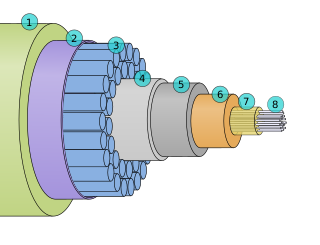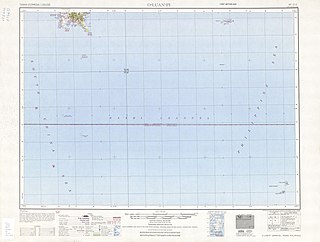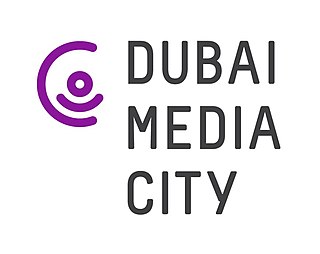
The Strait of Hormuz is a strait between the Persian Gulf and the Gulf of Oman. It provides the only sea passage from the Persian Gulf to the open ocean and is one of the world's most strategically important choke points. On the north coast lies Iran, and on the south coast lies the Musandam peninsula, shared by the United Arab Emirates and the Musandam Governorate, an exclave of Oman. The strait is about 90 nautical miles (167 km) long, with a width varying from about 52 nmi (96 km) to 21 nmi (39 km).
Telecommunications in the United Arab Emirates (UAE) is under the control and supervision of the Telecommunications and Digital Government Regulatory Authority which was established under UAE Federal Law by Decree No. 3 of 2003. From 1976 to 2006 the Emirates Telecommunications Corporation (Etisalat) was the sole telephone and telecommunications provider for the UAE. And while there were exceptions for free zones and modern housing developments, for the majority of the UAE, Etisalat held a monopoly on business and personal telecommunications services. In February 2006, this monopoly became a duopoly when a new telephone company and Internet service provider (ISP), du, was established to offer mobile services across the UAE and Internet and TV services to some free zone areas. However, due to geographical distribution of service areas, the companies do not compete for customers and thus effectively operate as monopolies. Earlier du provided triple play services to free zone areas under the name Emirates Integrated Telecommunications Company (EITC), which is still its legal name.

CANTAT-3 was the third Canadian transatlantic telecommunications cable, in regular operation from 1994 to 2010, carrying 3 x 2.5 Gbit/s between Canada and Europe. It branches to both Iceland and the Faroe Islands. It is out of normal service for international bandwidth and is currently operated by Føroya Tele to service oil platforms in the North Sea.

A submarine communications cable is a cable laid on the seabed between land-based stations to carry telecommunication signals across stretches of ocean and sea. The first submarine communications cables were laid beginning in the 1850s and carried telegraphy traffic, establishing the first instant telecommunications links between continents, such as the first transatlantic telegraph cable which became operational on 16 August 1858.

SAT-3/WASC or South Atlantic 3/West Africa Submarine Cable is a submarine communications cable linking Portugal and Spain to South Africa, with connections to several West African countries along the route.

The Bashi Channel is a waterway between Mavulis Island of the Philippines and Orchid Island of Taiwan. It is a part of the Luzon Strait between the East China Sea and the South China Sea. It is characterized by windy storms during the rainy period, which lasts from June to December.
Fibre-optic Link Around the Globe (FLAG) is a 28,000-kilometre-long fibre optic mostly-submarine communications cable that connects the United Kingdom, Japan, India, and many places in between. The cable is operated by Global Cloud Xchange, a subsidiary of RCOM. The system runs from the eastern coast of North America to Japan. Its Europe–Asia segment was the fourth longest cable in the world in 2008.
SEA-ME-WE3 or South-East Asia - Middle East - Western Europe 3 is an optical submarine telecommunications cable linking those regions and is the longest in the world. Completed in late 2000, it is led by France Telecom and China Telecom, and is administered by Singtel, a telecommunications operator owned by the Government of Singapore. The Consortium is formed by 92 other investors from the telecom industry. It was commissioned in March 2000.

South East Asia–Middle East–Western Europe 4 is an optical fibre submarine communications cable system that carries telecommunications between Singapore, Malaysia, Thailand, Bangladesh, India, Sri Lanka, Pakistan, United Arab Emirates, Saudi Arabia, Egypt, Italy, Tunisia, Algeria and France. It is intended to be a complement to, rather than a replacement for, the SEA-ME-WE 3 cable.
APCN 2 or Asia-Pacific Cable Network 2 is a submarine telecommunications cable linking several countries in the Asia-Pacific region.

Dubai Media City (DMC), part of Dubai Holding, is a tax-free zone within Dubai, United Arab Emirates.

The 2006 Hengchun earthquakes occurred on December 26 at 20:26 and 20:34 local time off the southwest coast of Taiwan in the Luzon Strait, which connects the South China Sea with the Philippine Sea. The International Seismological Centre measured the shocks at 7.0 and 6.9 on the moment magnitude scale. The earthquakes not only caused casualties and building damage, but several submarine communications cables were cut, disrupting telecommunication services in various parts of Asia.
TEAMS is an initiative spearheaded by the government of Kenya to link the country to the rest of the world through a submarine fibre optic cable. It was first proposed as an alternative to EASSy, the East African Submarine Cable System. The Kenyan government had grown frustrated with the ownership model favoured by South Africa, the time it was taking and what it perceived as an attempt by South Africa to control the cable. As a result, in November 2006, the Kenyan government decided to partner with the Emirates Telecommunication Establishment (Etisalat) to build its own fibre optic cable.
Like many developed and developing countries, the Internet in Bangladesh has witnessed significant growth. Although facing many constraints in expanding Internet access and use, development of the Internet and Information Technology are high government priorities. In March, 2021 Internet users in Bangladesh increased to 116 million. On 19 February 2018, Bangladesh started the 4G network service.
The 2008 submarine cable disruption refers to three separate incidents of major damage to submarine optical communication cables around the world. The first incident caused damage involving up to five high-speed Internet submarine communications cables in the Mediterranean Sea and Middle East from 23 January to 4 February 2008, causing internet disruptions and slowdowns for users in the Middle East and India. The incident called into doubt the safety of the undersea portion of the Internet cable system.
SHEFA-2 is an undersea communication cable linking the Faroe Islands to mainland Scotland via the Northern Isles. It is named after the route on which it is being deployed (SHEtland-FAroes) and succeeds an earlier cable called SHEFA-1 on the same route.
Europe India Gateway (EIG) is a submarine communications cable system that connects the U.K., Portugal, Gibraltar, Monaco, France, Libya, Egypt, Saudi Arabia, Djibouti, Oman, United Arab Emirates, and India.
The Asia-America Gateway (AAG) is a 20,000-kilometre (12,000 mi) long submarine communications cable system, connecting South-East Asia with the mainland of the United States, across the Pacific Ocean via Guam and Hawaii.

An Internet outage or Internet blackout or Internet shutdown is the complete or partial failure of the internet services. It can occur due to censorship, cyberattacks, disasters, police or security services actions or errors.
Asia-Africa-Europe 1 (AAE-1) is a 25,000 km submarine communications cable system from South East Asia to Europe across Egypt, connecting Hong Kong, Vietnam, Cambodia, Malaysia, Singapore, Thailand, Myanmar, India, Pakistan, Oman, UAE, Qatar, Yemen, Djibouti, Saudi Arabia, Egypt, Greece, Italy, and France. The AAE-1 cable has capacity of at least 40 terabits per second (Tbit/s) to supply the broadband market across Asia, Africa and Europe. In July 2017, it was launched for commercial services and is the longest submarine cable system in over a decade.








